Ever heard your relatives or friends discussing how memorable their trip to Badrinath temple was? It would indeed be, given the beautiful landscape of this temple which is an abode to Lord Vishnu. The number of devotees visiting Badrinath is increasing manifold with each passing season.
In common practice, Badrinath and Kedarnath are referred to together but people can even choose to visit separately, depending on their preference. If this holy place has been on your mind since long, it is high time you dive deep into the details and plan out for yourself! Read on to go on a journey loaded with apt information on Badrinath temple.
Table of Contents
Architecture and Location
The architecture is one of the most revered features of the Badrinath temple. The intricate beauty, coupled with mountains all around makes this temple a perfect place for both devotion and enjoying the aesthetic scenic beauty. The snowclad temple looks next to heaven, even from a distance. The decoration during the Badri Kedar Festival and the Mata Murti Mela further enhances the beauty. Salient features of Badrinath temple architecture are as follows:
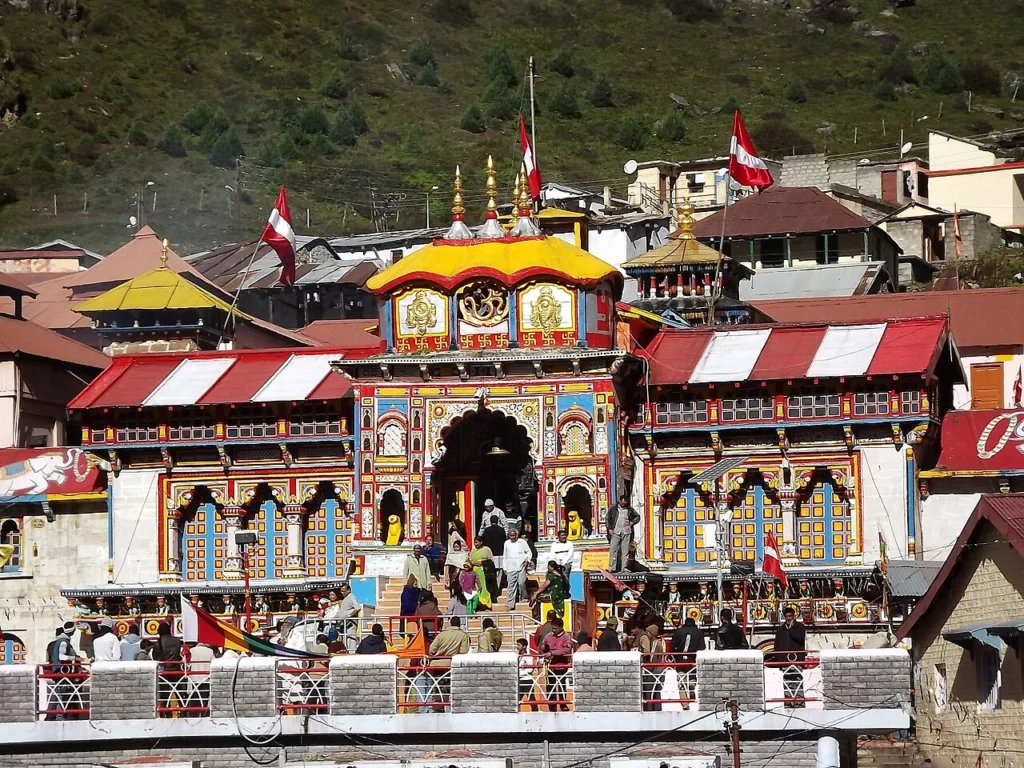
- In addition to the main idol, the nearby complex has other deities too, all carved out of stone.
- These include Narayana, Uddhava, Narada and Nara.
- The main idol of Lord Vishnu is a stark representation of the meditative posture where the deity can be seen seated in the lotus position, holding a Shankha and Chakra respectively in both hands.
- The outer structure has arched windows, which have intricate carving. Though the idol is monochrome, the temple’s colorful decor is sure to give you an enchanting experience.
- The entrance is adorned by paintings from medieval times and much more intricate carvings, also known as the Singhdwar.
- The complete structure is made up of stone slabs, which have been strategically placed to maintain the sanctum sanctorum of the temple.
The Badrinath temple is located in the Chamoli District of Devbhoomi, Uttarakhand. The estimated height is close to 10,300 feet and you need to go towards the Garhwal Himalayas to reach this temple. As you ascend, the Alaknanda river also offers resplendent views and the sound of water further enhances the experience. The temple dates back to the eighth century, which is why it has such high significance.
Be careful to follow the guidelines wherever provided. There have been instances of people getting into mishaps while trying to record themselves or other pursuits. Taking care of the Badrinath temple and the surrounding areas is the duty of all the visitors and locals alike. A large inflow of tourists is seen during Kapat Kholna and Kapat Bandh, due to the high mythological significance of the opening and closing ceremonies, respectively. The location of the shrine changes to Joshimath in the winter season.
History of Badrinath Temple
Indian theologian Adi Shankaracharya is a highly revered figure when it comes to tracing the history of the Badrinath temple. He has been a torchbearer of Hinduism and is known to have established the Badrinath temple by placing the Badrinath idol at its present place. It is believed that while travelling. Shankaracharya found the idol in Alaknanda river. There was a cave near Tapt Kund at that time, which was the initial resting place of the idol. In addition to this, the whole Char Dham yatra owes its existence to Adi Shankaracharya because he focused on propagating Hinduism through pilgrimage.
The Avatar of Lord Vishnu seated in Badrinath Temple is known as Badri Narayan. The meaning of Badri is a place which is full of berry trees. This is true for the original area where this temple is located, though some parts have changed due to change in environment. Hindu followers hold this deity in high regards and some people even have a ritual of visiting this shrine once in a year, believing that the deity offers protection and in addition, all wishes are fulfilled. On the other hand, the temple is also a part of Divya Desams which is a cultural heritage of Vaishnavites. It is believed that the temple opens doors to salvation, also known as Moksha in Hindu spirituality.
The history is much more important because this temple is known to be seated as the Satya Yuga, which is the oldest one known to mankind. The belief is that there will be no rebirth if a Hindu visits all four shrines of Char Dham and attain Moksha.
The Cultural Significance
According to recent visitors, the most striking feature of this temple is that it is not limited to Hindu devotees. People from all walks of life, whether professing Hindu religion or not, are equally welcome. Many people believe it to be their path to solace, as they have deep faith in Lord Vishnu. The frequent visitors talk about a shift in aura when they reach the temple, and the peaceful environment makes them feel like there is definitely some divine intervention.
The same holds true for the Kedarnath shrine as well. The mythological aspect revolves around the fact that it is the abode of Lord Vishnu and the deity is known to be special for a plethora of reasons (ranging from the establishment of the temple to the way in which it has been maintained till date). Irrespective of your purpose of visit, you are sure to find something that you can cherish. Though the most common purpose is spiritual retreat or as a part of Char Dham, you can choose your purpose and delve deeper into the religious aura of the Badrinath temple.
Badrinath Temple: One of the Char Dham Pilgrimages
This temple owes its existence to Adi Shankara, for maintaining the yugas and their relevance. The vedic rituals started at that time are still being followed with full dedication and faith. The special feature of Badrinath temple is that it is a part of Char Dham yatra as well as the Chota Char Dham.
More on these two:
Char Dham = Badrinath, Dwarka, Puri, Rameswaram
Chota Char Dham = Gangotri, Yamunotri, Kedarnath and Badrinath.
There is a captivating backstory as well. Earlier, the area was known as Badarikavana, that is, forest of berries. The story is related to Lord Vishnu meditating over here when his wife saw his state and decided to protect him. The deity is seated in lotus position in the actual temple because of the fact that Lord Vishnu was actually seated in that position when he was originally meditating at that particular point. To save her husband, Goddess Lakshmi turned into “Badri”, that is, a berry tree in order to offer shade to her meditating husband. While common belief might make you think that it is named after Lord Vishnu, legend holds that it is more about his wife.
Now you might be wondering why is this Dham so popular and part of so many people’s bucket list? It is because of the breathtaking view of the Himalayas all around and the beautiful forestry all around. As we have already discussed the splendid architectural style it adds to the overall beauty.
How to reach Badrinath Temple?
Once you have dates and companions sorted, decide your mode of transportation for a seamless Darshan experience. You can reach through helicopter or road transport, depending on the amount you are willing to spend and the time in hand.
Roadmap: Dehradun-Rishikesh-Devprayag-Srinagar-Rudraprayag-Auli–Joshimath-Badrinath
By air:
Reaching Dehradun by air is the first step, and then you can get on your preferred mode of transport. The nearest airport is Jolly Grant airport in Dehradun, from where you can opt for a private taxi or bus for further journey. The total distance between the airport and Badrinath temple is around 300 kilometres, so you would have to divide your trip accordingly.
By train:
Haridwar is the nearest railway station, around 150 kilometres away. After reaching the railway station, a combination of bus and taxi can be used.
By road:
The roads are motorable till Badrinath, and one can easily drive or go by cab. You can choose the route depending on your source city. Reaching Badrinath temple is possible from Delhi (assumed starting point) through Rishikesh as well as through Haridwar, if you plan to go by car.
Places to Visit Near Badrinath Temple
The temple is a haven for devotees in itself, but you can explore nearby areas as well if you are planning to stay for some more time. The following places can further enrich your pilgrimage experience and make you fall in love with the area:
1) Mana Village
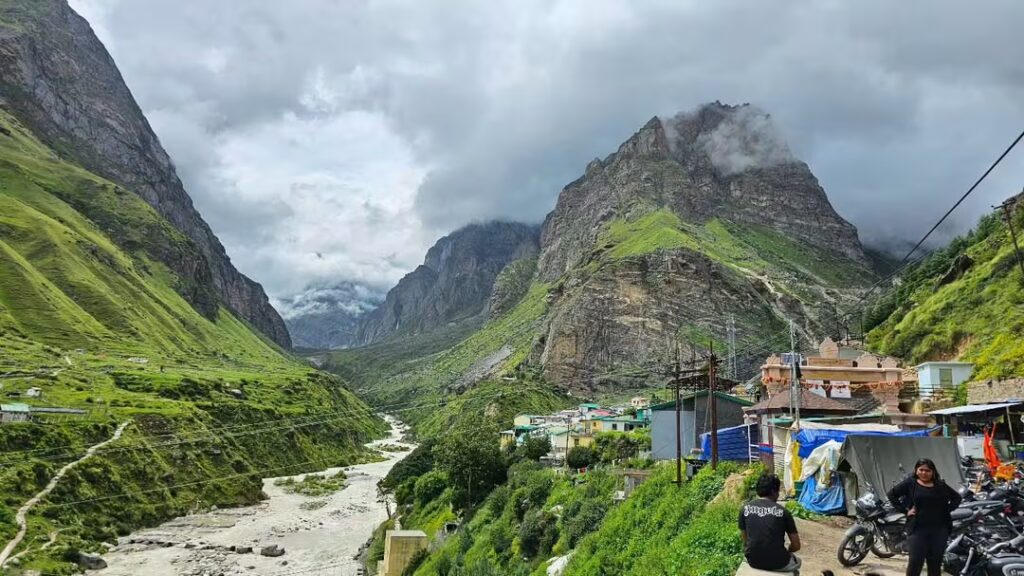
Mana the last Village of India
Also known as India’s first village before Tibet, this place will showcase Garhwal culture and tradition like nowhere else. It has a mythological significance because the epic Mahabharata is believed to be written here. Since it is just three kilometres from the Badrinath temple, you can plan a visit. The major attractions include Vyas gufa as well as Ganesh gufa.
2) Neelkanth Peak
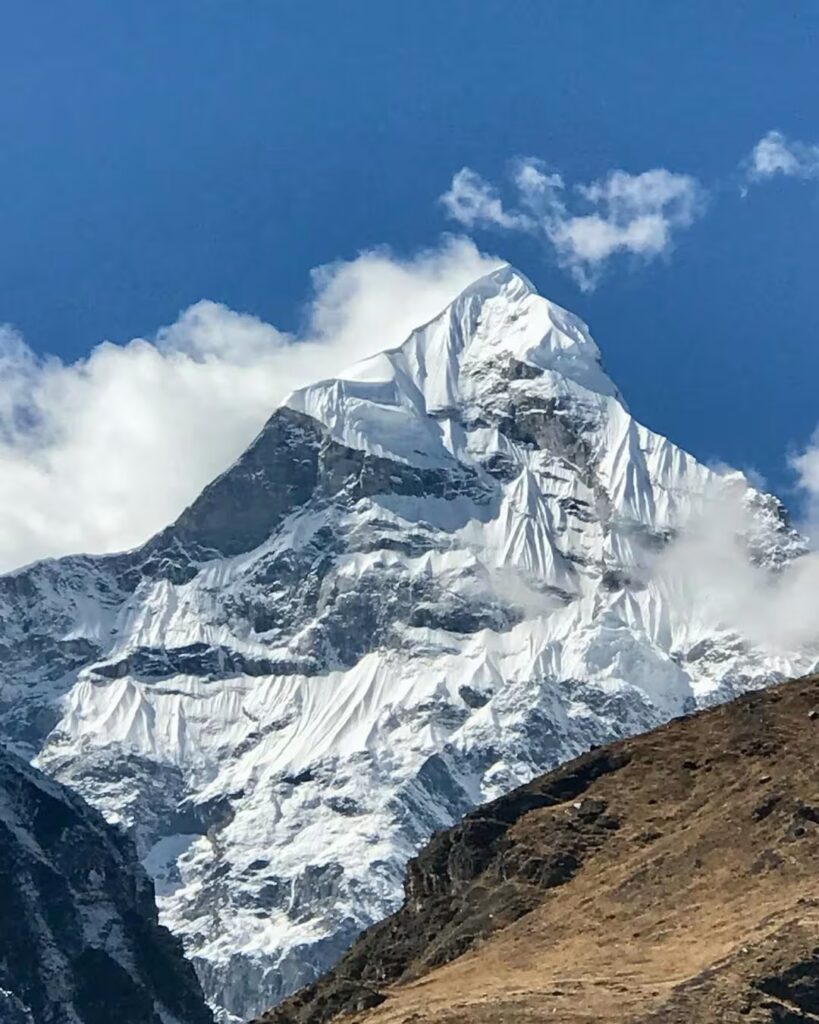
Neelkhant Peak
This peak has a cultural significance – one can see the Charanpaduka, which is believed to be the footprints of Lord Vishnu from the top. Devotees have this belief that when the deity was treading the hills, this is the place where he would have paused to rest. It is indeed a beautiful sight for those who believe in the story.
3) Valley of Flowers National Park
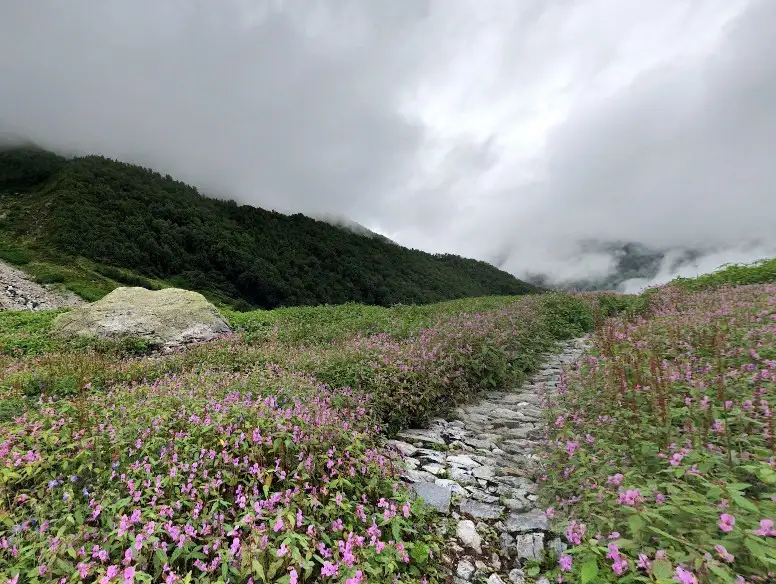
Valley of Flower
This park is a must visit for people who are interested in fauna. The varieties are peculiar to the region and the peaceful atmosphere all around makes the park a calming retreat for people wanting some time off from socialising. The best time to visit this place is in the monsoon season, as all the plants and trees are in their full bloom, forming a canopy for little sunlight to reach the ground.
4) Tapt Kund
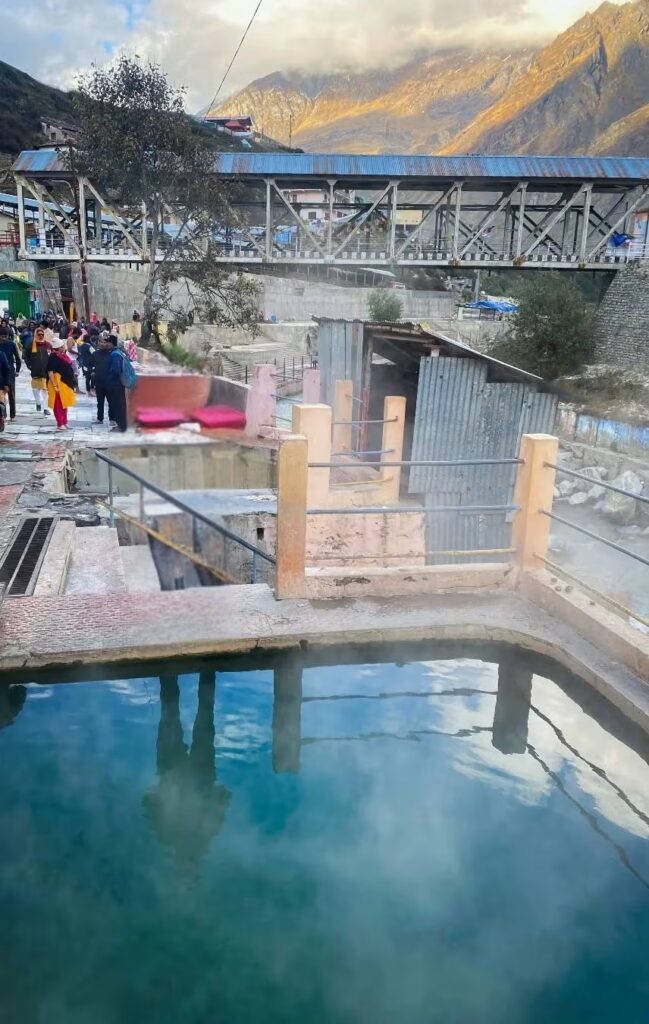
Tapt Kund In Badrinath Temple
Located just before the Badrinath temple, this hot water spring is named after the high temperature of water – “tapt”. People believe that the water is holy and as common for hot springs, it heals skin issues and offers other medicinal benefits as well. The importance is further increased by the fact that it is a natural hot spring located at such a height. It is a common practice to take a dip in this kund before they visit the holy shrine, believing that it purifies the body as well as the soul.
5) Satopanth Lake
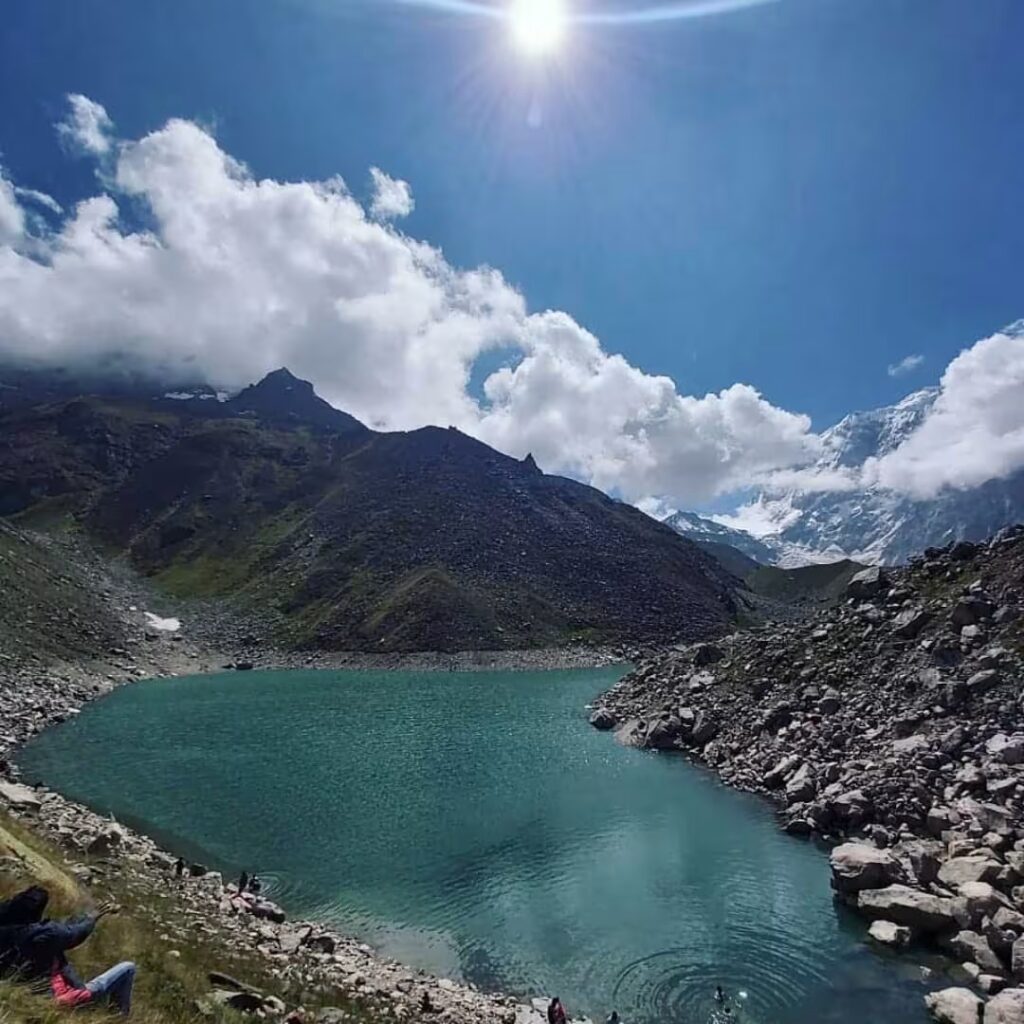
Satopanth Lake
It is a natural lake at about 4,500 metres above sea level. People visit this place in large numbers due to the belief that the Gods themselves visited this place to meditate whenever they wanted peace of mind.
The terrain is a bit difficult and one should exercise caution while moving towards the lake as the area might be slippery. It is also believed that in ancient times, this lake was frequently visited by Lord Brahma, Vishnu, and Shiva as it showed the path of truth (Satopanth, as the name suggests).
6) Vasudhara Falls
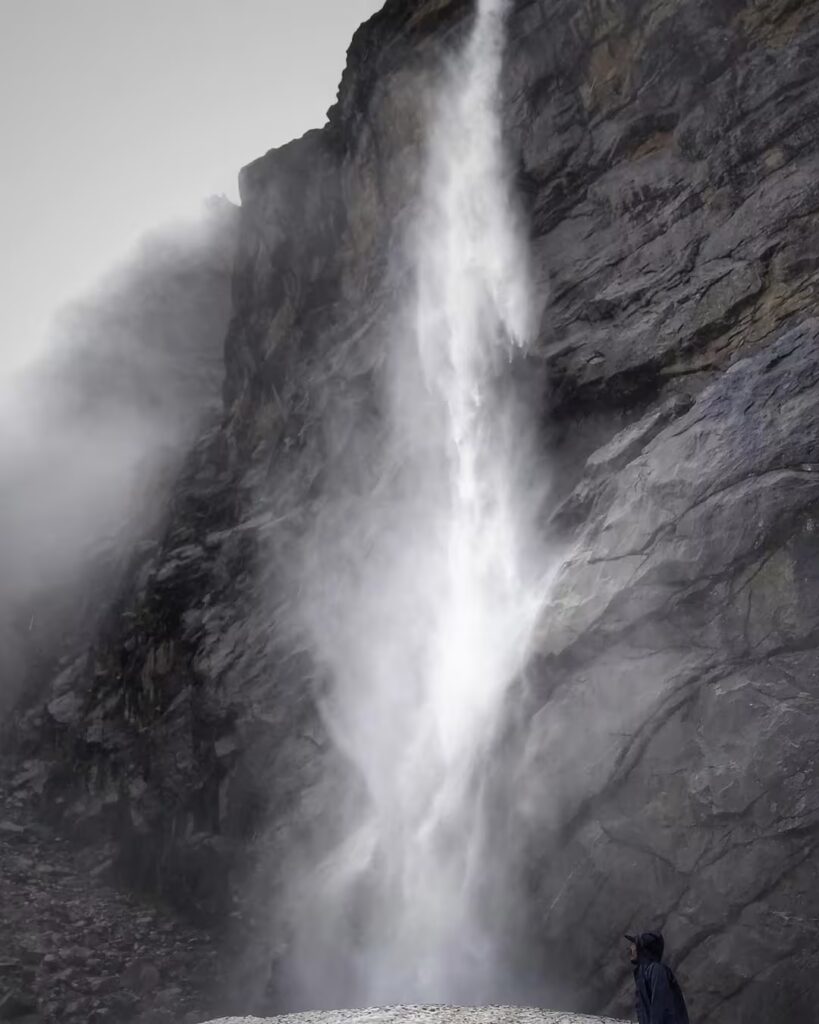
Vasudhara Falls
Vasudhara falls is located a bit far, approximately 10 kilometres away from Badrinath. Trekkers frequent this spot because of the remote area and difficult terrain. It is a peaceful place, full of greenery and sounds of water hitting the stones.
Best Time to Visit
Keep two things in mind before you decide when to visit the holy Badrinath temple – the weather at the time of visit and how safe the ascent would be. Early May to early July should be your preferred time. From November to April, the gates are closed due to unfavourable weather conditions. If you wish to go at a time when the crowd is less, go two to three weeks before closing time.
Irrespective of the month of visit, do not forget to carry warm clothes, especially targeting the neck area and a woollen cap. Do not let the afternoon sun deceive you, as the temperatures may reach sub zero levels as well, depending on the overall weather and breeze. It goes without saying that trekking shoes will make your life much easier over there. Raincoats are optional, but it is always better to stay cautious. In case you are travelling with someone with health issues, carry adequate medicines as they might not be accessible once you reach the temple.
Frequently Asked Questions
1) Is the aarti accessible to all in the Badrinath temple?
Yes. Something you cannot miss when you reach Badrinath temple is adhering to the timings of Aarti and daily Abhishek that takes place. In the Shivratri season, the overall vibe is completely different due to the change in decoration as well as additional arrangements. If you are going to visit Badrinath for religious temples, there is a provision for booking puja services as well, which offers a personalized experience. People who have indulged in such practices have shared their experiences online and were completely satisfied by the way the Pujaris (priests) at the temple made sure everything was next to perfect.
3) What are the timings of the Badrinath temple?
Timings are quite strict, between 1 pm and 4 pm, the temple is closed. At night, the last lot of darshans ends at 9 pm. This might change depending upon the weather, and the locals will prove to be your best guides in such scenarios. Do not hesitate to ask for help or seek directions.
4) Is adequate accommodation available near Badrinath temple?
As far as accommodation after reaching is concerned, it is always better to pre-book hotels and do your Char Dham Registration. First time travellers to the Badrinath shrine have been very vocal about the inflated prices if you visit in peak season and thus it is better to have your stay sorted before you head to the temple. For emergency conditions, ample options are available in the form of dharamshalas and affordable hotels. Make sure you keep the surroundings clean and respect the sanctity of Badrinath Dham as far as possible.
Conclusion
Whether you wish to visit this revered temple on your own or with family and friends, plan your trip well in advance to prevent any last moment hassles. A combination of serene beauty and high cultural significance, Badrinath temple is known to be the favourite spot for many people who have been on Char Dham yatras. A personal anecdote even claims that the chosen ones are called to this place, as the terrain might turn challenging at times (in common parlance, it is said that a devotee reaches a temple only when the deity invites).
As already discussed, the best time varies depending upon your purpose of visit. Now that you know everything about visiting Badrinath temple, get ready to make memories and have a mesmerising experience. Do not forget to explore the possibilities of an extended Char Dham yatra in continuation!
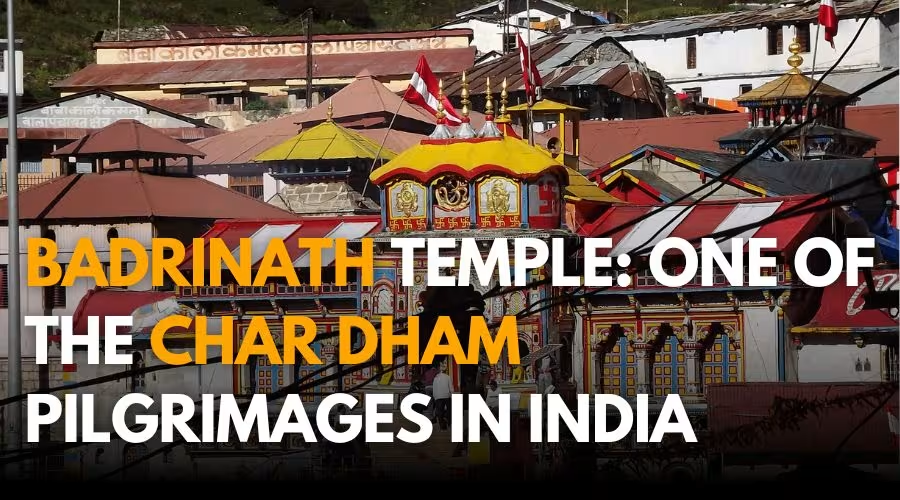
Leave a Comment